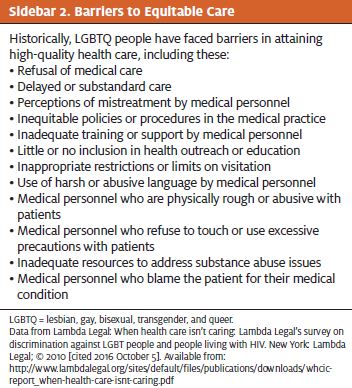Urgent message: There is a growing need for awareness of medical, safety, and social issues involving the lesbian, gay, bisexual, transgender, and queer community in health care. Here’s how urgent care fits in.
Introduction
There are significant unmet health needs among members of the U.S. lesbian, gay, bisexual, transgender, and queer (LGBTQ) population, many of whom are afraid to access the health-care system and face barriers to care even if they do seek treatment. Clearly there is room for urgent care centers to step up with services and customer service that welcome this community.
Nearly 4% of the U.S. population identifies as part of the LGBTQ community, according to a 2015 study.1 Population estimates fluctuate, partly because reporting methods are not always reliable. Research reported in 2016 showed that about 1.4 million adults in the United States identify as transgender, which is twice the previous estimate.2 That figure came from the Williams Institute at the UCLA School of Law, which focuses on law and poverty issues related to sexual orientation and gender identity, and was derived from studying a much larger database. “From prior research, we know that trans people are more likely to be from racial and ethnic minorities, particularly from Latino backgrounds,” Jody L. Herman, a public policy scholar at the Williams Institute, told the New York Times.3
Four main health disparities face the LGBTQ population. They are
- Less likely to have health insurance
- More likely to delay treatment or not seek medical care
- More likely to delay or not get needed prescription medicine
- More likely to seek care in an emergency department
As a whole, LGBTQ populations have the highest rates of tobacco, alcohol, and other drug use. Lesbian and bisexual females are more likely to be overweight or obese. The transgender population has a higher prevalence of human immunodeficiency virus (HIV), sexually transmitted infections (STIs), and mental health issues—and they are less likely to have health insurance coverage than heterosexual or LGBT individuals.4 A 2015 Kaiser Family Foundation study found the LGBTQ population has higher rates than other populations of chronic conditions such as asthma, hepatitis B and C, cancer, and cardiovascular disease.5
How to Offer Welcoming Care
A symposium held in September 2016 in North Carolina tackled discussion of how health-care providers can offer better care for the transgender community. Barriers, some of the speakers said, can start at the front desk if staff members embarrass a patient by addressing them by the wrong name and cause them to leave. There is much to be gained by cross-training center staff on procedures, terminology, and welcoming practices for those in the LGBTQ community.
“Train other people, it’ll save your workload and to have a cadre of clinicians in your area will save that one person who’s currently seeing everyone from burning out,” said Holiday Simmons, a black transgender Cherokee man and social worker, to symposium attendees. “For example, my primary care provider is that person in my area. People come from all over Georgia to see him, and I know he’s maxed out.”6
Training that raises the level of diversity awareness is key, said Dr. William Valenti, an specialist in infectious diseases and a senior vice president at Trillium Health in Rochester, New York. It helps to actually diversify your staff when possible. “They need to have sensitivity and awareness for patients, to be nonjudgmental and welcoming,” Valenti said. “Not everyone will be on the same page in terms of understanding, but a little understanding can go a long way.”
Offering Expanded Testing and Prophylaxis
There is an opportunity for urgent care centers to join in efforts for expanded testing for HIV and STIs. There are still about 55,000 new HIV infections in the United States each year. “I see urgent care as a partner in activities that deal with HIV testing and prevention, and in sexual health for LGBTQ people, particularly men who have sex with men,” Valenti said. “If we take a broad view of HIV testing and its importance, urgent care settings can be pivotal in that effort.”
The population at highest risk for HIV is men who are between the ages of 18 and 30 years. This younger demographic is most likely than older community members to get testing where they get their health care, and that is often in an urgent care setting because they do not have a relationship with a primary-care physician.
Urgent care centers can be another outlet for encouraging STI testing and rapid HIV screening. A number of recently reported cases of HIV were missed when the patients had prior encounters with the health system. If providers are considering a diagnosis of infectious mononucleosis, they should also do a rapid HIV rest to rule out that type of infection.
Further, urgent care providers can encourage pre-exposure prophylaxis treatment for those in the at-risk population who have negative test results for HIV. This one-pill-a-day regimen reduces HIV risk by 95% in the people who take it.
Urgent care centers likely will not be able to provide long-term care for a patient with positive test results for HIV. However, providers can make referrals, get those patients connected to the health-care system, and help prevent further spread of infection.

 Bias in Health Care
Bias in Health Care
The popularity of patient-centered care is resurging, and the implementation of such care must be purposeful and intentional (Sidebar 1). Learning some key terminology regarding the LGBTQ population is a good start, but you may want to go farther at your center and conduct an assessment of unconscious bias among staff members. Harvard University offers for free online the Implicit Association Test,7 which measures the associations between concepts that can help measure attitudes and beliefs that people may be unwilling or unable to report.
The implicit bias measured on the test’s website is pervasive. The research findings have prompted many organizations, including health-care groups, to step up training and open lines of communication. When bias (Sidebar 2) plays out in health-care settings, it can go beyond making a patient feel uncomfortable—it can mean the difference between lifesaving care and death.
Conclusion
There are several steps to be considered in the urgent care setting for better addressing the health-care gaps facing the LGBTQ population:
- Management can work with organizations that offer ongoing training for staff members to broaden their cultural and medical understanding of a variety of patient groups.
- Management can ask employees to explore (or test) their implicit bias to help them recognize areas for improvement.
- Urgent care centers can conduct specific outreach to the LGBTQ community about testing services offered or can host community education programs to raise awareness.
Providers across the country are striving toward patient-centered care with this population and others. The medical community is also working to rebuild trust with the LGBTQ community after decades of blatant discrimination that began during the epidemic of HIV and acquired immunodeficiency syndrome (AIDS) in the early 1980s. Urgent care centers can and should play a role in reaching these communities through outreach and convenient care.
References
- Newport F, Gates GJ. San Francisco metro area ranks highest in LGBT percentage. Washington DC: Gallup [published 2015 March 20]. Available from: http://www.gallup.com/poll/182051/san-francisco-metro-area-ranks-highest-lgbt-percentage.aspx
- Flores AR, Herman JL, Gates GJ, Brown NT. How many adults identify as transgender in the United States? Los Angeles, CA: The Williams Institute, UCLA School of Law [published 2016 June]. Available from: http://williamsinstitute.law.ucla.edu/wp-content/uploads/How-Many-Adults-Identify-as-Transgender-in-the-United-States.pdf
- Hoffman J. Estimates of U.S. transgender population doubles to 1.4 million adults. New York Times. 2016 June 30. Available from: http://www.nytimes.com/2016/07/01/health/transgender-population.html
- Lesbian, gay, bisexual, and transgender health. Washington DC: Office of Disease Prevention and Health Promotion; © 2014 [last updated 2016 December 1]. Available from: https://www.healthypeople.gov/2020/topics-objectives/topic/lesbian-gay-bisexual-and-transgender-health
- Kates J, Ranji U, Beamesderfer A, et al. Health and access to care and coverage for lesbian, gay, bisexual, and transgender individuals in the U.S. Menlo Park, CA: Henry J. Kaiser Family Foundation [published 2016 November]. Available from: http://files.kff.org/attachment/Issue-Brief-Health-and-Access-to-Care-and-Coverage-for-LGBT-Individuals-in-the-US
- Hoban R. Symposium gives providers insight on transgender patients. North Carolina Health News. 2016 September 28. Available from: http://www.northcarolinahealthnews.org/2016/09/28/symposium-gives-providers-insight-on-transgender-patients/
- Project Implicit. Overview [of the Implicit Association Test]. Available from: https://implicit.harvard.edu/implicit/education.html
Alan A. Ayers, MBA, MAcc, is Vice President of Strategic Initiatives for Practice Velocity, LLC and is Practice Management Editor of the Journal of Urgent Care Medicine. Dorothy Wallheimer is a freelance writer and a veteran journalist of 10 years from Rockford, Illinois.

